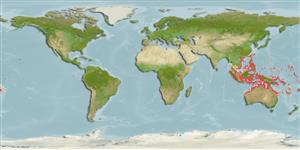Teleostei (teleosts) >
Acanthuriformes (Surgeonfishes) >
Siganidae (Rabbitfishes)
Etymology: Siganus: Latin, siganus = a fish, rabbit fish; by the similarity of the nose (Ref. 45335).
More on authors: Schlegel & Müller.
Environment: milieu / climate zone / depth range / distribution range
Ecology
Marine; reef-associated; depth range 0 - 30 m (Ref. 128797), usually 1 - 30 m (Ref. 27115). Tropical; 26°N - 25°S, 95°E - 173°W
Western Pacific: western Philippines, Indonesia, New Guinea, Great Barrier Reef, Vanuatu (sighting), New Caledonia, Caroline Islands, Marshall Islands, Nauru (sighting) and Kiribati (sighting). Recently recorded from Tonga (Ref. 53797).
Size / Weight / Age
Maturity: Lm ? range ? - ? cm
Max length : 25.0 cm SL male/unsexed; (Ref. 48637); common length : 20.0 cm TL male/unsexed; (Ref. 9813)
Dorsal spines (total): 13; Dorsal soft rays (total): 10; Anal spines: 7; Anal soft rays: 9; Vertebrae: 13. A dark chocolate ocular band running in an arc from base of 1st dorsal spine to chin; a narrow white blaze on midline of head profile; thorax dark chocolate; a broad white zone behind ocular bar on trunk; remainder of body yellow-orange. Stout, pungent, venomous spines. Caudal fin only slightly incised. Fully scaled midline of thorax. Preopercular angle 119° (111°-120°). Variable cheek scaling; usually overlapping scales, 8-10 rows deep below center of orbit; occasionally, few scattered scales; area fully scaled from lower edge of orbit 2 angle of mouth. S. vulpinus is very closely related to and possibly the same as S. unimaculatus, which has a large black blotch on the sides beneath the soft dorsal rays (Ref. 37816).
Sometimes territorial, occurs in coral-rich areas of lagoon and seaward reefs. Often among staghorn corals (Ref. 90102). Usually occurs singly or in pairs, but juveniles and subadults occasionally occur in large schools among Acropora where they feed on algae growing on the dead bases of the coral branches. Capable of inflicting painful stings (Ref. 4690, 48637).
Life cycle and mating behavior
Maturity | Reproduction | Spawning | Eggs | Fecundity | Larvae
Woodland, D.J., 1990. Revision of the fish family Siganidae with descriptions of two new species and comments on distribution and biology. Indo-Pac. Fish. (19):136 p. (Ref. 1419)
IUCN Red List Status (Ref. 130435: Version 2024-1)
Human uses
Fisheries: minor commercial; aquarium: commercial
Tools
Special reports
Download XML
Internet sources
Estimates based on models
Preferred temperature (Ref.
123201): 24.7 - 29, mean 27.6 °C (based on 720 cells).
Phylogenetic diversity index (Ref.
82804): PD
50 = 0.5000 [Uniqueness, from 0.5 = low to 2.0 = high].
Bayesian length-weight: a=0.01445 (0.00642 - 0.03257), b=3.07 (2.89 - 3.25), in cm total length, based on LWR estimates for this Genus-body shape (Ref.
93245).
Trophic level (Ref.
69278): 2.7 ±0.30 se; based on food items.
Resilience (Ref.
120179): High, minimum population doubling time less than 15 months (Preliminary K or Fecundity.).
Fishing Vulnerability (Ref.
59153): Low vulnerability (21 of 100).
Nutrients (Ref.
124155): Calcium = 43.1 [20.6, 99.4] mg/100g; Iron = 0.684 [0.332, 1.623] mg/100g; Protein = 18.7 [17.2, 20.2] %; Omega3 = 0.116 [0.060, 0.231] g/100g; Selenium = 20.1 [8.1, 49.9] μg/100g; VitaminA = 39.6 [11.1, 136.7] μg/100g; Zinc = 1.27 [0.50, 2.71] mg/100g (wet weight);
